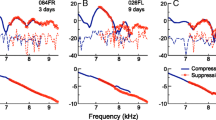Abstract
In this study, we utilized the swept-tone (ST) deconvolution method for comparing the signal-to-noise ratio (SNR) characteristics of ST otoacoustic emissions (OAE) to conventionally acquired click, or transient-evoked (TE), OAE. We generated a hearing-level equalized (HLeq) ST stimulus based on normative loudness metrics at the different frequencies present in the ST. Due to noise-shaping properties of the ST deconvolution method, we anticipated a theoretical SNR gain of +4.26 dB in STOAE compared to TEOAE acquired under comparable settings. This prediction was confirmed by computer simulation. HLeq STOAE and TEOAE were then acquired from each of the 22 ears that were tested at five stimulation levels from 5 to 45 dB HL, and analyzed responses in terms of their overall SNR. We found that the overall SNR of the HLeq STOAE responses at stimulation levels at or above 15 dB HL was significantly higher than that of TEOAE by an average of +3.6 dB. Importantly, this leads to recording quality and time-saving improvements in clinical hearing screenings.





Similar content being viewed by others
References
Abdala C, Dhar S (2010) Distortion product otoacoustic emission phase and component analysis in human newborns. J Acoust Soc Am 127:316–325
Bennett CL, Özdamar Ö (2010) High-frequency transient evoked otoacoustic emissions acquisition with auditory canal compensated clicks using swept-tone analysis. J Acoust Soc Am 127:2410–2419
Bennett CL, Özdamar Ö (2010) Swept-tone transient evoked otoacoustic emissions. J Acoust Soc Am 128:1833–1844
Bennett C, Harris D, Tankanow A, Twilley R (2010) Effects of oversampling on SNR using swept-sine analysis. Presented at the 129th audio engineering society convention, 4–7 Nov, San Francisco, CA: 8232
Burkard R (1984) Sound pressure level measurement and spectral analysis of brief acoustic transients. Electroencephalogr Clin Neurophysiol 57:83–91
Dau T, Wegner O, Mellert V, Kollmeier B (2000) Auditory brainstem responses with optimized chirp signals compensating basilar-membrane dispersion. J Acoust Soc Am 107:1530–1540
Delgado RE, Özdamar Ö, Rahman S, Lopez CN (2000) Adaptive noise cancellation in a multimicrophone system for distortion product otoacoustic emission acquisition. IEEE T Bio-Med Eng 47:1154–1164
Deng J, Chen S, Zeng X, Li G (2013) Using a dynamic tracking filter to extract distortion product otoacoustic emissions evoked with swept-tone signals. IEEE T Biomed Health Inform 18:1186–1195
Durrant JD, Collet L (2007) Integrating otoacoustic emissions and electrophysiologic measures as the basis for differential diagnostic applications. In: Robinette MS, Glattke TJ (eds) Otoacoustic emissions: clinical applications, 3rd edn. Thieme, New York, pp 273–295
Elberling C, Don M, Cebulla M, Stürzebecher E (2007) Auditory steady-state responses to chirp stimuli based on cochlear traveling wave delay. J Acoust Soc Am 122:2772–2785
Glattke TJ, Pafitis IA, Cummiskey C, Herer GR (1995) Identification of hearing loss in children and young adults using measures of transient otoacoustic emission reproducibility. Am J Audiol 4:71–86
ISO (2003) Acoustics—normal equal-loudness-level contours. International Standards Organization: 226
Janušauskas A, Marozas V, Engdahl B, Hoffman HJ, Svensson O, Sörnmo L (2001) Otoacoustic emissions and improved pass/fail separation using wavelet analysis and time windowing. Med Biol Eng Comput 39:134–139
Janušauskas A, Sörnmo L, Svensson O, Engdahl B (2002) Detection of transient-evoked otoacoustic emissions and the design of time windows. IEEE T Bio -Med Eng 49:132–139
Jedrzejczak WW, Kochanek K, Sliwa L, Pilka E, Piotrowska A, Skarzynski H (2013) Chirp-evoked otoacoustic emissions in children. Int J Pediatr Otorhinolaryngol 77:101–106
Kalluri R, Shera CA (2007) Comparing stimulus-frequency otoacoustic emissions measured by compression, suppression, and spectral smoothing. J Acoust Soc Am 122:3562–3575
Kalluri R, Shera CA (2007) Near equivalence of human click-evoked and stimulus-frequency otoacoustic emissions. J Acoust Soc Am 121:2097–2110
Kalluri R, Shera CA (2013) Measuring stimulus-frequency otoacoustic emissions using swept tones. J Acoust Soc Am 134:356–368
Kemp DT, Ryan S, Bray P (1990) Otoacoustic emission analysis and interpretation for clinical purposes. Adv Audiol 7:77–98
Kramer SJ (2013) Audiology: science to practice. Plural Publishing, San Diego
Long GR, Talmadge CL, Lee J (2008) Measuring distortion product otoacoustic emissions using continuously sweeping primaries. J Acoust Soc Am 124:1613–1626
Lonsbury-Martin BL, Whitehead ML, Martin GK (1991) Clinical applications of otoacoustic emissions. J Speech Hear Res 34:964–981
Mihajloski T, Lachowska M, Bennett CL, Ozdamar O (2011) Hearing level equalized otoacoustic emissions acquired by swept-tones: Intensity characteristics. In: Conferences Proceedings IEEE Eng Med Biol Soc, Boston, MA, 30 Aug 3 Sep 818–821
Muller S, Massarani P (2001) Transfer-function measurement with sweeps. J Audio Eng Soc 49:443–471
Neumann J, Uppenkamp S, Kollmeier B (1994) Chirp evoked otoacoustic emissions. Hear Res 79:17–25
Novak A, Simon L, Kadlec F, Lotton P (2010) Nonlinear system identification using exponential swept-sine signal. IEEE T Instrum Meas 59:2220–2229
Prieve BA, Schooling T, Venediktov R, Franceschini N (2015) An evidence-based systematic review on the diagnostic accuracy of hearing screening instruments for preschool- and school-age children. Am J Audiol 24:250–267
Ravazzani P, Tognola G, Grandori F, Ruohonen J (1998) Two-dimensional filter to facilitate detection of transient-evoked otoacoustic emissions. IEEE T Bio-Med Eng 45:1089–1096
Ravazzani P, Tognola G, Parazzini M, Grandori F (2003) Principal component analysis as a method to facilitate fast detection of transient-evoked otoacoustic emissions. IEEE T Bio-Med Eng 50:249–252
Siegel J, Hirohata E (1994) Sound calibration and distortion product otoacoustic emissions at high frequencies. Hear Res 80:146–152
Verhulst S, Harte JM, Dau T (2008) Temporal suppression and augmentation of click-evoked otoacoustic emissions. Hear Res 246:23–35
Yang L, Young S, Kuo T (2002) Modification of the wavelet method used in transiently evoked otoacoustic emission pass/fail criterion to increase its accuracy. Med Biol Eng Comput 40:34–40
Author information
Authors and Affiliations
Corresponding author
Rights and permissions
About this article
Cite this article
Bennett, C.L., Mihajloski, T. & Özdamar, Ö. Signal-to-noise ratio improvement of swept-tone-generated transient otoacoustic emissions. Med Biol Eng Comput 55, 69–78 (2017). https://doi.org/10.1007/s11517-016-1507-8
Received:
Accepted:
Published:
Issue Date:
DOI: https://doi.org/10.1007/s11517-016-1507-8




